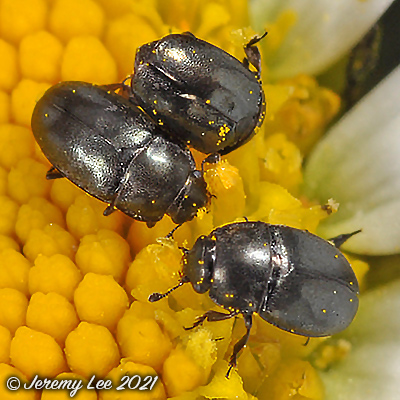
 |
|
Scientific Classifications explained » Amphibians » Ants » Aphids » Bees » Beetles » Birds » Bugs » Butterflies » Caterpillars » Damselflies » Dragonflies » Earwigs » Flies » Frog/Leafhoppers » Fungi » Galls » Grasshoppers » Harvestmen » Hoverflies » Lacewings » Ladybirds » Leaf Mines » Lichens » Mammals » Millipedes » Mosses » Moths » Sawflies » Slugs » Snails » Spiders » Trees » Wasps » Wild Flowers » Woodlice |
UK Nature > Beetles > Meligethes aeneus

Scientific Name: Meligethes aeneus Common Name: Pollen Beetle Meligethes aeneus, more commonly known as a Pollen Beetle, is a small black beetle with a metallic black or blue-green sheen. There are several very similar pollen beetles but Meligethes aeneus is the most common, particularly early in the year. It can be found on most flowers and particularly common on fields of Oil Seed Rape. On the wing from spring to late autumn, they are attracted to yellow flowers and indeed most things yellow, including clothing and tennis balls. They occur in large numbers, feeding mainly on pollen but sometimes gnawing on the flower parts. They are an important pollinator though can be a pest of Oil Seed Rape. The larvae feed on the sexual parts of flowers of plants in the Cabbage family, causing the flower to abort. Very common and often abundant particularly in England and Wales. |
|

https://www.uknature.co.uk is a website dedicated to showing the immense diversity of UK nature and wildlife. Our vast range of habitats, from lowland arable to snow covered mountains, from storm-ravaged coastlines to peaceful inland freshwater lakes and rivers, from dry, sandy heaths to deciduous and coniferous forests, all these habitats contribute to the abundance of UK nature. We have wild birds in huge numbers either residing or visiting our shores (597 recorded species as at July 2013) and we must also not forget the humble back garden with its grass lawns, flower beds filled with nectar rich flowers, shrubs and trees, all designed to attract huge numbers of insects such as bees, moths, butterflies and hoverflies; and finally the small ponds which provide safe havens for frogs, toads, newts and even slow worms and grass snakes. www.uknature.co.uk is the showcase for my personal passion, photographing uknature in all its glory. I sincerely hope you all enjoy the fruits of my labours. This site and all images contained therein is © Jeremy Lee 2004 - 2021. All Rights Reserved. Site design by Jeremy Lee. Site development & IT Support by Stuart Lee. |